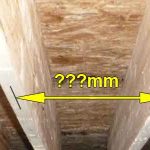Joists are the structural timbers in a property, that support the ceilings and floors above them. In most instances, the joists are covered by floorboards and plastered ceilings. So, they are rarely left exposed.
This may leave you wondering, what type of wood are joists made from? For example, are they made from softwoods like pine, birch, and spruce? Or are they made from hardwoods, such as oak, walnut and ash.
You might assume they need to be hardwood, as they will be supporting large amounts of weight. However, this is not the case.

Timber joists used in construction, are made from softwood. Despite the name, softwood joists are very strong, and can easily support the floors in a property. Different thickness and depth of joist will be used. This will depend on how far they span without additional support.
A structural engineer will usually specify the joists that are required. This will consider the span of the joists and the load that will be supported above.
Other reasons hardwoods are not used for joists include:
- For purely aesthetic reasons – hardwoods are far better suited to more decorative features, such as flooring and furniture.
- Hardwoods are denser and heavier – This makes them much more difficult to work with. Both lifting and cutting hardwoods, is much more of a challenge compared with softwoods.
- Cost of timber – Hardwoods tend to be more expensive than softwoods. Even a relatively affordable hardwood, such as oak, would be considerably more expensive than a common softwood such as pine.
- Availability and sustainability – Softwoods are much more readily available. They grow much faster and are far easier to re-plant and replace than hardwoods.
Are hardwoods ever used for joists?
It is very unlikely you will find anyone using hardwoods for standard ceiling and floor joists. If hardwoods are ever used, it is more often decorative. In most cases, this would usually be in the form of things like exposed oak beams.
A good example would be old properties with exposed beams and joists. Here an oak beam would potentially offer two advantages.
- It would look great – Exposed oak beams add lots of character and are a beautiful decorative feature.
- Provides structural support for joists – Before structural steel beams were readily available, large oak beams would be one way to create structural support for joists.
Hardwoods usually have deeper colours and more intricate defined grains. This makes them much more popular for visible features, such as exposed flooring, furniture, and high-end internal joinery. This includes things like, doors, skirting, architraves, and kitchen worktops.
Are any other materials ever used for joists?
As we mentioned previously. In general, standard timber joists will always be made of softwoods. This is the same for the vast majority of framing timber used in construction. For example, stud walls, roof trusses, joists, etc, will all usually be softwood.
However, solid timber is not the only material used to create joists. There are also popular engineered joists, that can be used in place of timber.
The most common engineered joists are open web, and I joists. To be fair, both of these are still partially made from softwood.
Open web joists
Open web joists, or posi joists, consist of a top and bottom timber flange, made from softwood. Then in between the two flanges, there is a steel webbing that ads support to the joists. These joists can have some advantaged depending on the job. Some of the main ones include:
- They can span greater distances.
- The steel webbing is open, so pipes and wires can easily run through without the need to drill holes in the joist.
- Lightweight and easy to install. This means that they can be installed quicker, which can save on labour costs.
I Joists
I joist are similar to open web joists, in that they have timber flanges at the top and bottom. However, unlike open web, they have a solid middle. This sits between the top and bottom flange, creating and I shaped joist, hence the name.
In I joists, the flange is either made of solid softwood timber, or a laminated veneer lumber (LVL). The LVL is an engineered wood, that is made by gluing and compressing thin layers of timber. This produces a strong, straight, and durable product that is less prone to twisting, warping and shrinkage.
The web is generally made of another engineered wood, such as OSB. Due to their structure, they have good tensile strength, and can be spanned over longer distances than traditional solid timber joists.
Whilst these engineered joists are not solid softwood. The components that they are made of, are almost entirely made from softwoods. All the wood used to engineer both LVL and OSB is softwood.
The only parts that are not softwoods, are the chemical adhesives used to form the engineered woods. As well as the metal webbing in posi joists.
Conclusion
Joists are nearly always made from solid softwood. The exception to this rule, would be engineered joists, such as posi joists and I joists. However, even these manufactured products, are still made almost entirely of softwood.
Hardwood is not generally used for joists. Although, it can sometimes be used as a decorative feature in exposed joists and beams. It is also quite common for old buildings to have used hardwood beams, in place of more modern structural steel beams.




